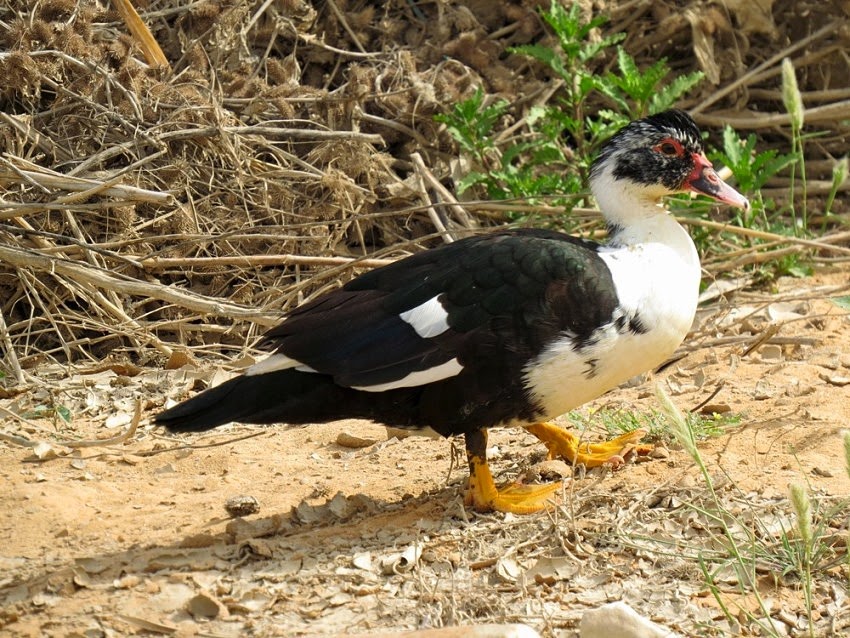Indeed it was my first visit for over 6 weeks.
We spent most of our time following the "Riyadh river" south of the landmark bridge. This decision was made because of so much recent disturbance through earth movement and reed clearances in areas further north.
Eurasian reed warbler
Early on the walk we concentrated on the reeds themselves. I wondered whether my target species of little crake had arrived on passage but none were seen in typical places like where the water spills out from the edge of the reeds. Elsewhere we saw streaked weaver in reeds to the north and then plenty of reed warbler, house sparrow and graceful prinia to the south of the bridge.
Some of the reed warbler sounds weren't quite right and were too loud and continuous. The mystery was solved when a clamorous reed warbler popped up temporarily into view. This species isn't know conclusively to breed here but is know to disperse outside the breeding season. Know breeding sites near Hofuf are 225 kilometres way.
Bluethroat
Wintering bluethroat were still around, all at the start of the walk (and on return).
common kingfisher
Remarkably, a common kingfisher seen in November and January was in almost exactly the same place again. Surely it will soon be time for it to travel north out of Saudi Arabia. (Incidentally one of the local white throated kingfisher was seen as we drove off at the end of the session near the bridge.)
moorhen
After walking past the heavily reeded areas, we continued walking south where the Riyadh river widens out and cover is more sparse.
squacco heron
This was an area of grey heron, purple heron, squacco heron and little egret as well as waders.
grey heron
(Five black crowned night heron had been seen before the walk begin).
black crowned night heron
The waders in the wider river and sparsely vegetated area were very shy, flying off from a great distance out.
green sandpiper
The shyest of all were green sandpiper. Common sandpiper were nearly as timid.
black winged stilt
Black winged stilt were the bravest and allowed a little closer contact.
common snipe
Two common snipe were typically behaved. As ever, if you see them first you have a chance of some approach.
spur winged plover and little egret
Spur winged plover as being increasingly seen at Al Hayer. Three years ago they were only in Kharj to the south. I can say confidently their range is now expanding into the Al Hayer area.
little ringed plover
By contrast, Little ringed plover has been a long standing summer bird there.
yellow wagtail and white wagtail
Surprisingly, there were only a few signs of passage. One of these was a lone yellow wagtail. It was the first sighting of one by me this season.
grey wagtail
On the other hand, I have seen more grey wagtail this year than in previous years throughout the country.
local barn swallow
Barn swallow and a small flock of high flying and non-stopping European bee-eater were other signs of passage. The barn swallow shown above are not passage birds however. This small group are local breeders who could be seen flying in and out of a small barn with nests once again this year.
greater spotted eagle
Although the focus of the day was on the southern stretch of the river with waders and birds close to the reeds, there were other interesting observations too.
Two greater spotted eagle were seen.
Turkestan shrike
Turkestan shrike aren't as common as Daurian shrike, but one was observed in the pivot fields near the bridge.
pied wheatear
A single pied wheatear was seen travelling to al Hayer. This my first sighting this spring of this passage bird.
Muscovy duck
Finally but not necessarily least: there was a Muscovy duck swimming free near the bridge. As far as I know there is no duck farming in Saudi Arabia and this bird is almost certainly an escape from a private collection.
As I may have said at some time in previous blogs, I want to match and exceed Pers Bertilsson's list of 336 species seen in Saudi Arabia (see page tab in this blog called "The biggest Saudi list and where"). My total is 321 as recorded on e-bird. However I notice that Pers includes one escaped non-breeder in his list. So to be consistent with Pers, I either increase my list by one to 322 or I decrease Pers list by one to 335. Either way, I am now 15 species short. I have vowed not to leave Saudi Arabia until this is achieved.
It could be a long wait.




















No comments:
Post a Comment